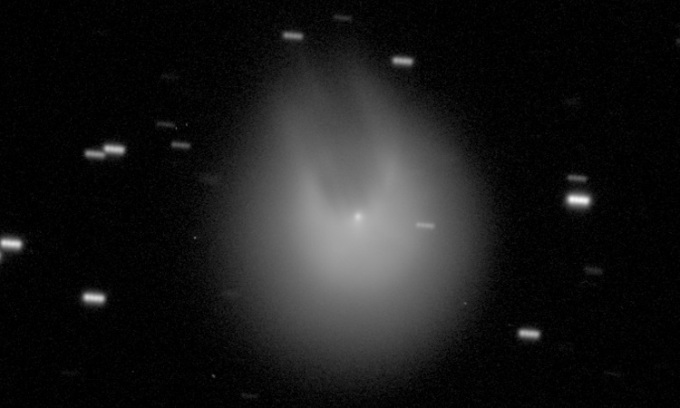A city-sized explosive comet called 12P/Pons–Brooks is approaching its closest point to Earth in its 71-year orbit through the solar system.

Comet 12P/Pons-Brook (12P) in this image taken on July 26. Photo: Comet Chasers/Richard Miles
An unusual volcanic comet hurtling toward the Sun appeared to grow horns after exploding, brightening it like a tiny star and dumping supercooled magma into space. It was the first time scientists had seen the comet erupt in nearly 70 years.
Comet 12P/Pons-Brooks (12P) is a cryogenic volcanic comet. Like all comets, this icy body consists of a solid core of a mixture of ice, dust, and gas, surrounded by a gas cloud called a cometary cap. But unlike most comets, the gas and ice inside 12P's core have accumulated so much that it can explode violently, shooting cold material called icy magma through large cracks in its core.
On July 20, astronomers detected a major eruption from the comet, causing it to suddenly become about 100 times brighter than usual, according to Spaceweather.com . This increase in brightness occurred when the comet's shell suddenly swelled with gas and ice crystals released from inside, allowing it to reflect more sunlight back to Earth.
On July 26, the comet’s outer shell grew to a diameter of 230,000 kilometers (140,000 miles), 7,000 times wider than its nucleus, which was 30 kilometers (18 miles) across, said Richard Miles, a researcher at the British Astronomical Association and an expert on cold volcanic comets. But what’s interesting is the unusual shape of the expanding shell, which makes the comet look like it has grown horns. Other experts have likened the deformed comet to the Millennium Falcon, one of the famous spaceships from the Star Wars movies.
The unusual shape of the comet's shell is likely due to deformations in 12P's nucleus. The outflowing gas may be partially blocked by the spikes in the nucleus, forming a V-shape in the shell. As the gas continues to flow away from the comet, the V-shape becomes more pronounced. But eventually the expanding shell will disappear when the gas and ice are too dispersed to reflect sunlight.
This is the first major eruption detected from 12P in 69 years, Miles said, largely because the comet's orbit keeps it too far from Earth to see. 12P takes about 71 years to complete its orbit around the sun, during which time it has been pushed to the farthest edge of the solar system. The comet will reach its closest approach to the sun on April 21, 2024, and its closest approach to Earth on June 2, 2024, making it visible to the naked eye in the night sky.
In addition to 12P, researchers have recorded several eruptions over the past few years from 29P/Schwassmann-Wachmann (29P), the most volatile volcanic comet in the Solar System. In December 2022, astronomers witnessed the largest eruption from 29P in 12 years, spewing about a million tons of cold magma into space.
An Khang (According to Live Science )
Source link




















































![[Maritime News] More than 80% of global container shipping capacity is in the hands of MSC and major shipping alliances](https://vphoto.vietnam.vn/thumb/402x226/vietnam/resource/IMAGE/2025/7/16/6b4d586c984b4cbf8c5680352b9eaeb0)













































Comment (0)